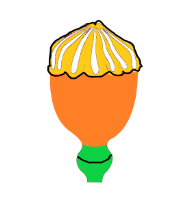
Identify the type of ovary in the diagram

A)Multicarpellary apocarpous
B)Multicarpellary syncarpous
C)Multicarpellary pistillate
D)Monocarpellary apocarpous

Answer
479.1k+ views
Hint: In botany, the ovary is an expanded basal part of the pistil, the female floral gland. The ovary contains ovules, which upon fertilisation, grow into seeds. The ovary itself will grow into a fruit enclosing the seeds, either dry or fleshy.
Complete answer:
Carpel is one of the leaflike, seed-bearing structures that make up a flower's innermost whorl. The pistil is shaped by one or more carpels. Fertilization of an egg from another flower inside a carpel by a pollen grain results in seed production within the carpel.
The female reproductive component of the flower, interpreted as modified leaves bearing structures called ovules, within which the egg cells gradually develop and consist of ovaries, style and stigma, is a carpel. The pistil may consist of one carpel, with its ovary, style and stigma, or may be joined together by several carpels with a single ovary, a whole unit called a pistil.
Gynoecium may consist of one or more pistils of unicarpellate (with one carpel) or of one pistil of multi carpellate. Words such as tricarpellate (three carpels) define the number of carpelsPhylogenetically derived from ovule-bearing leaves or leaf homologues, megasporophylls are known to be carpels that have formed a closed structure containing the ovules. Normally, this structure is rolled and fused along the margin.
Multicarpellary and syncarpous ovaries are shown in the given figure. It means that there are several carpels fused together.
There is multicarpellary and syncarpous gynoecium in tomato and brinjal. Carpels are more than one and fused in this situation.
Hence, the correct answer is option (B)
Note: Multicarpellary, single-flower apocarpous ovaries were produced by fruitlet groups.This form of aggregate fruit is known as fruitlet aggregate.Often a syncarpous gynoecium may look very much like a monocarpous gynecium.
Complete answer:
Carpel is one of the leaflike, seed-bearing structures that make up a flower's innermost whorl. The pistil is shaped by one or more carpels. Fertilization of an egg from another flower inside a carpel by a pollen grain results in seed production within the carpel.
The female reproductive component of the flower, interpreted as modified leaves bearing structures called ovules, within which the egg cells gradually develop and consist of ovaries, style and stigma, is a carpel. The pistil may consist of one carpel, with its ovary, style and stigma, or may be joined together by several carpels with a single ovary, a whole unit called a pistil.
Gynoecium may consist of one or more pistils of unicarpellate (with one carpel) or of one pistil of multi carpellate. Words such as tricarpellate (three carpels) define the number of carpelsPhylogenetically derived from ovule-bearing leaves or leaf homologues, megasporophylls are known to be carpels that have formed a closed structure containing the ovules. Normally, this structure is rolled and fused along the margin.
Multicarpellary and syncarpous ovaries are shown in the given figure. It means that there are several carpels fused together.
There is multicarpellary and syncarpous gynoecium in tomato and brinjal. Carpels are more than one and fused in this situation.
Hence, the correct answer is option (B)
Note: Multicarpellary, single-flower apocarpous ovaries were produced by fruitlet groups.This form of aggregate fruit is known as fruitlet aggregate.Often a syncarpous gynoecium may look very much like a monocarpous gynecium.
Recently Updated Pages
Master Class 11 Economics: Engaging Questions & Answers for Success

Master Class 11 Business Studies: Engaging Questions & Answers for Success

Master Class 11 Accountancy: Engaging Questions & Answers for Success

Master Class 11 English: Engaging Questions & Answers for Success

Master Class 11 Computer Science: Engaging Questions & Answers for Success

Master Class 11 Maths: Engaging Questions & Answers for Success

Trending doubts
In which part of the body the blood is purified oxygenation class 11 biology CBSE

1 Quintal is equal to a 110 kg b 10 kg c 100kg d 1000 class 11 physics CBSE

Find the value of the expression given below sin 30circ class 11 maths CBSE

If the HCF of 657 and 963 is expressible in the fo-class-11-maths-CBSE

How do I convert ms to kmh Give an example class 11 physics CBSE

How many ATP molecules are produced from the complete class 11 biology CBSE




